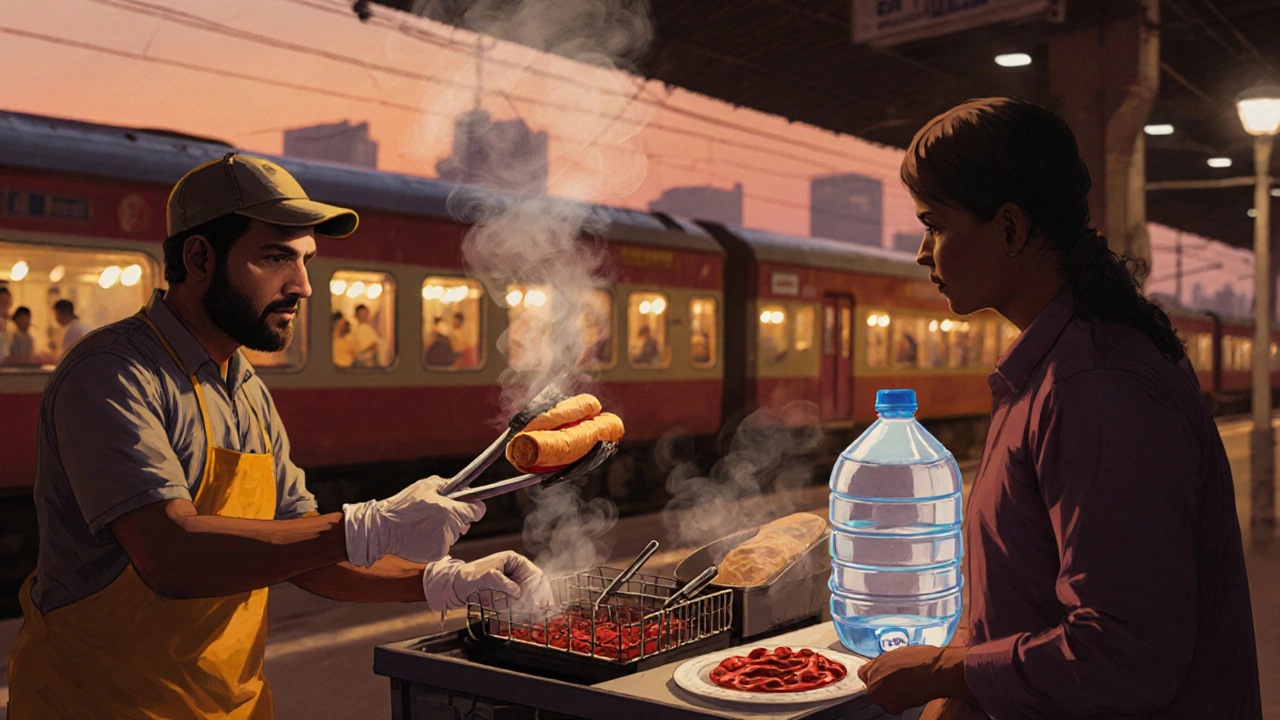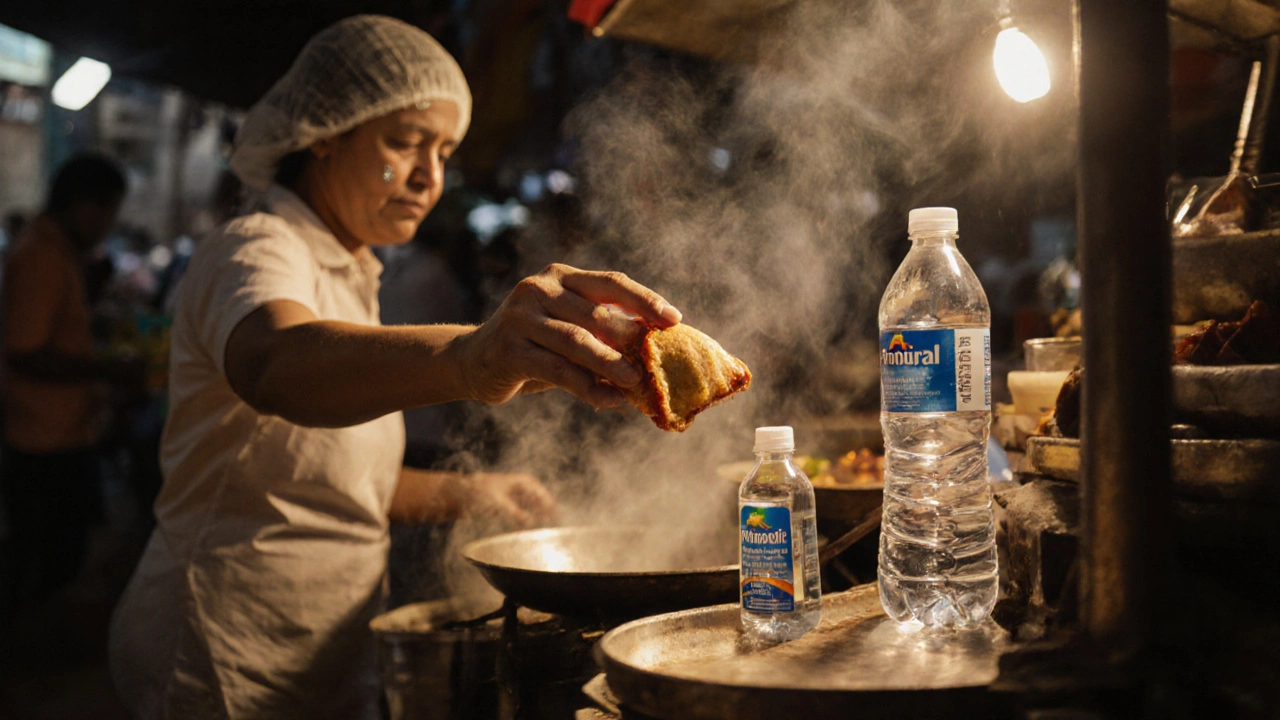Every year, millions of travelers head to India for its vibrant culture, ancient temples, and-above all-its street food. The sizzle of samosas in hot oil, the tang of chaat, the sweet steam of jalebi fresh off the griddle. It’s unforgettable. But right behind that excitement comes the question: is it safe to eat street food in India? The answer isn’t yes or no. It’s about how you choose, where you go, and what you watch.
Street food in India isn’t just food-it’s culture
Street food in India isn’t a side note. It’s the heartbeat of daily life. In Delhi, you’ll find vendors serving pani puri before sunrise. In Mumbai, vada pav carts line railway stations. In Jaipur, pyaaz kachori is eaten with chai at 8 a.m. These aren’t just meals-they’re rituals passed down for generations. Most vendors have been making the same dishes for 20, 30, even 50 years. Their reputation depends on one thing: keeping customers healthy and coming back.
Studies from the Indian Council of Medical Research show that over 70% of street food vendors in major cities follow basic hygiene practices, like using clean utensils and covering food. That’s higher than many assume. The real risk isn’t the food itself-it’s inconsistency. A vendor who’s clean today might cut corners tomorrow if they’re overwhelmed. So you don’t need to avoid street food. You need to learn how to pick the right spots.
How to tell if a street food stall is safe
Here’s what to look for, no matter which city you’re in:
- High turnover: If a stall is crowded with locals, especially during lunch or dinner hours, it’s a good sign. Food doesn’t sit around. It’s made fresh, fast, and sold quickly.
- Clean hands and gloves: Watch how the vendor handles money and food. Do they wash their hands? Do they use tongs or gloves to serve? If they touch food after handling cash without washing, walk away.
- Food is served hot: Heat kills bacteria. If your chaat or pakora is lukewarm, it’s been sitting too long. Always ask for it fresh.
- Water source matters: Avoid anything washed in tap water-like raw vegetables or fruit. Look for stalls that use bottled or filtered water. If you see a big jug labeled "mineral water" or "RO water," that’s a green flag.
- Visible cooking: You should be able to see the oil being heated, the batter frying, the spices being added. If the food is hidden behind a counter, you can’t judge how clean it is.
One of the safest bets? Go where the workers are wearing caps or hairnets. It’s not always required by law, but if they’re using them, they care about presentation-and hygiene.
What street foods are safest to try
Not all street foods carry the same risk. Some are naturally low-risk because of how they’re made:
- Hot samosas and pakoras: Deep-fried in fresh oil. The high heat kills most pathogens. Just make sure they’re crispy and hot when you get them.
- Chai (Indian tea): Boiled water, milk, and spices. If it’s freshly made and served hot, it’s one of the safest drinks you can have.
- Grilled corn or roasted peanuts: Simple, dry heat, no water involved. Easy to trust.
- Tandoori roti or naan: Baked in a clay oven at over 480°F (250°C). No chance for bacteria to survive.
- Coconut water: Straight from the shell, served immediately. No added water, no storage.
On the other hand, avoid:
- Raw salads or unpeeled fruit (even if washed)
- Ice in drinks (unless you’re sure it’s made from purified water)
- Pre-cut melons or fruits sitting in open air
- Any dish with mayonnaise or dairy left unrefrigerated

What to do if you get sick
Even with all the precautions, your stomach might rebel. That doesn’t mean you did something wrong. Your gut isn’t used to the spices, the bacteria, or the heat. Most cases of traveler’s diarrhea are mild and last 1-3 days.
Here’s what to do:
- Drink oral rehydration solution (ORS). You can buy it at any pharmacy in India. It’s cheap, effective, and saves you from dehydration.
- Stick to bland foods: rice, toast, boiled potatoes, bananas.
- Don’t take antibiotics unless prescribed. Most cases don’t need them.
- If you have a fever, bloody stool, or vomiting for more than 24 hours, see a doctor. Many cities have clinics for travelers.
Travelers who take probiotics before and during their trip report fewer stomach issues. A 2024 study in the Journal of Travel Medicine found that travelers who took Lactobacillus rhamnosus GG reduced their risk of diarrhea by 37%. It’s not a guarantee, but it helps.
Myths about street food safety
Let’s clear up some common misunderstandings:
- Myth: Only tourists get sick from street food. Truth: Locals get stomach upsets too-but they’ve built up tolerance. That doesn’t mean the food is unsafe. It means their bodies are adapted.
- Myth: You need to avoid street food entirely for the first week. Truth: There’s no magic waiting period. If you start with safe options and listen to your body, you can eat street food on day one.
- Myth: Expensive street food is safer. Truth: Price doesn’t equal hygiene. Some of the cleanest stalls are the cheapest ones.
- Myth: Bottled water means you’re safe. Truth: You can still get sick from food washed in tap water or handled by someone with dirty hands.

Real stories from real travelers
Emma, a 28-year-old teacher from Canada, ate pani puri on her third day in Varanasi. She didn’t get sick. Why? She watched the vendor pour water from a sealed bottle into the puri. She waited for it to be served hot. She didn’t touch the chutney with her fingers. She ate it standing up, smiling, and didn’t look back.
James, a 35-year-old engineer from Australia, ate a fruit chaat from a stall with no visible water source. He got sick for two days. He didn’t blame the vendor-he blamed himself for not asking questions.
It’s not about luck. It’s about awareness.
Final tips for eating street food in India
- Start slow. Try one item at a time. Don’t overload your system.
- Carry hand sanitizer. Use it before you eat, even if you’re using utensils.
- Don’t be shy. Ask, "Is this water purified?" Most vendors will nod and point to the jug.
- Trust your nose. If something smells off, walk away. Your instincts are sharper than you think.
- Keep a small supply of anti-diarrheal meds, but don’t rely on them as a safety net.
Eating street food in India isn’t a gamble. It’s a skill. And like any skill, it gets better with practice. The food is too good to miss. Just don’t skip the learning curve.
Is it safe to eat street food in India for first-time visitors?
Yes, it’s safe if you follow simple rules: choose busy stalls, eat food that’s hot and freshly cooked, avoid raw produce washed in tap water, and watch how the vendor handles money and food. Most travelers eat street food without issues by being observant, not avoiding it.
What street food should I avoid in India?
Avoid raw salads, unpeeled fruit, ice in drinks, pre-cut melons, and anything with dairy that’s not kept cold. Also skip dishes where you can’t see the cooking process-like hidden curries or sauces. Stick to fried, grilled, or boiled items served hot.
Can I drink water from street vendors in India?
Only if you’re sure it’s from a sealed bottle or a filtered RO system. Most street vendors don’t serve water directly. If they do, ask where it comes from. Bottled water is the safest option. Never drink tap water, even if it’s been boiled.
Do Indian street food vendors use clean utensils?
Many do, especially in tourist areas or busy cities. Look for tongs, gloves, or clean cloths used to handle food. If they use bare hands to serve after touching money, it’s a red flag. Always ask for utensils if you’re unsure.
Should I take probiotics before eating street food in India?
It’s a smart idea. A 2024 study showed travelers who took Lactobacillus rhamnosus GG reduced their risk of diarrhea by 37%. Probiotics don’t guarantee protection, but they support your gut’s ability to handle new bacteria. Take them for a few days before and during your trip.
How common is food poisoning from street food in India?
It’s less common than people think. Studies show that over 70% of street food vendors follow basic hygiene rules. Most cases of illness come from poor personal hygiene (like not washing hands) or drinking contaminated water-not the food itself. Travelers who are cautious rarely get sick.
Next steps: How to enjoy street food with confidence
Before your trip, download a local food safety app like "India Street Food Guide"-it lists verified stalls in major cities with photos and hygiene ratings. Talk to your hotel staff. They know which vendors are trusted by locals. Bring a small bottle of hand sanitizer and a reusable spoon. Eat with curiosity, not fear.
Street food in India isn’t dangerous. It’s alive. It’s loud, spicy, messy, and real. The best way to experience it isn’t to hide from it-it’s to learn how to choose wisely. And when you do, you’ll taste something no restaurant can replicate: the flavor of a country that feeds its people with pride, passion, and a whole lot of love.
